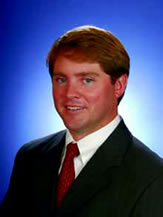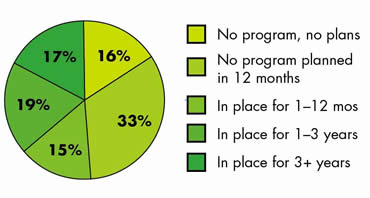 Powering Up Quality at Ford Powering Up Quality at Ford
For Ford Motor Co., "The Way Forward" is paying off in higher initial quality.
"Our 2007 initial quality study (IQS) results contain some encouraging and positive news for Ford," says Neal Oddes, director of product research and analysis at J.D. Power and Associates, a global marketing information and survey firm. "Fourteen Ford models placed in the top three of their respective segments—an achievement unmatched by any other corporation this year—which is a testament to the improvement in quality for Ford vehicle models and plants."
Five nameplates either fully or partially owned by Ford won their respective segments—Ford Mustang, Lincoln Mark LT, Lincoln MKZ, Mercury Milan, and Mazda MX-5 Miata.
The IQS serves as the industry benchmark for new-vehicle quality measured at 90 days of ownership and captures problems experienced by owners in two distinct categories—quality of design and quality of production (defects and malfunctions). During the past 20 years, the automotive industry has improved its quality by more than 120 percent. In addition, the study has found that the automotive industry has reduced problem counts by 50 percent every seven to eight years.
To obtain the data used in the study, J.D. Power's researchers sent out more than 459,000 survey forms to people who bought or leased new vehicles for personal use between Nov. 1, 2006, and Jan. 31, 2007. Commercial vehicles were not included in the survey. Respondents were asked to indicate any and all problems that they experienced with their vehicles within the first 90 days of ownership using a checklist of 228 individual problems or problem symptoms. They were also encouraged to write in any problems that were not included on the questionnaire. Problems are listed as either a defect/malfunction (part damaged or not working properly), or a design problem (component or feature works properly as designed but is perceived by owner to be difficult or complicated to use).
Of the more than 459,000 surveys mailed out, more than 97,000 usable returns were used in tabulating the results. "We set a return target of 450 returns for each model," says John Tews, director of media relations for J.D. Powers. "A minimum sample of 100 is deemed sufficient to ensure statistical accuracy and validity. For most high-volume models, we receive more than 1,000 returns."
Overall, Ford, Lincoln, and Mercury nameplates placed among the top 10 nameplates, with Lincoln in third place, Mercury in eighth place, and the Ford brand in 10th. Jaguar ranked sixth. Ford received 14 total vehicle honors, more than any other automaker. In addition to the five first-place winners, the following vehicles also were recognized as second-place winners:
• Ford F-150 LD: Large pickup
• Lincoln MKX: Midsize premium multi-activity vehicle
• Lincoln Navigator: Large premium multi-activity vehicle
Third-place winners included:
• Ford Fusion: Midsize car
• Ford Econoline: Van
• Ford Five Hundred: Large car
• Mercury Montego: Large car (tied with the Five Hundred)
• Mercury Mountaineer: Midsize multi-activity vehicle
• Volvo S80: Midsize premium car
"We are designing and building world-class vehicles, and it's great to have this affirmation from the customers who drive our cars and trucks every day," says Mark Fields, president of The Americas division of Ford Motor Co. "While we're pleased that our internal focus on quality is receiving this kind of recognition from J.D. Power and Associates, we will not let up. We will continue to deliver even more high-quality products that customers want."
Ford's overall ranking in the survey climbed to fourth place from last year's seventh, helped in part by the performance of the company's recently launched vehicles.
"We saw dramatic improvement from Lincoln," says Oddes. "It was a fantastic year for the Mercury Milan, with dramatic improvements in terms of defects."
Overall, Ford's strength came from new launches such as the Edge, Lincoln MKX, and Lincoln MKZ. Ford spokeswoman Anne Marie Gattari says that those launches point out what Ford is doing right.
"What we saw today is the result of several years of adhering to our design and manufacturing processes with complete discipline," she says. "It took some time for the results to be evident."
For more information, visit online at www.jdpower.com.
The Lincoln MKX received second place for midsize premium multiactivity vehicle.
Do the Math
Readers poured over last month's puzzle with a fine-toothed comb and came up with not one, but two errors in Jim Harrington's April 2007 column.
In the first of the two errors that our editors missed, Harrington said that Ivory Soap was only 99.4-percent pure. Well, as any baby boomer knows, Ivory soap is actually 99.44-percent pure. Patrick Corcoran, who submitted this error to us, suggested that although this 400 ppm error might be just a small fact-checking error for Quality Digest, an actual slip in purity by that amount could make heads roll at Proctor & Gamble. As requested, Corcoran gets a big jar of Jiffy peanut butter for his "Do the Math" suggestion.
The second error involves these two sentences: "The man was injected with 10 times the proper dosage of a chemotherapy drug—500 mg instead of 50 mg. He received a second 50-mg injection before his severe symptoms of toxic overdose were diagnosed a week later and his family was notified." The logical error is that the patient could not have received a "second 50-mg injection" because he never received a first 50-mg injection. The second sentence should have read, "He received a second injection, this one of 50 mg, before his… "
Congratulations to Arvind Srivastava for submitting the correct answer. Arvind is winner of a pseudo-random gift, chosen nearly blindfolded from woot.com.
Several of you spotted the glaring error in our May 2007 "Do the Math." The error is discussed in our "Letters" section on page 6.
Unfortunately we don't have a "Do the Math" question for this month. We hope to have one next time. Any suggestions?
Quality News from China
The 13th Asia Pacific Quality Organization International Conference and the Sixth Shanghai International Symposium on Quality, hosted by APQO and the China Association for Quality, and organized by the Shanghai Association for Quality, will be held October 18–20, 2007, in Shanghai, China.
Since the first APQO international conference was held in Beijing in 1985, the conference has become one of the world's most influential quality events. This is the third time that the conference will be held in China.
The theme of this year's conference, "Excellence and Harmony," refers to providing excellent products and service to customers by advocating the application of excellence-management approaches. Harmony means promoting an effective management model that ensures food safety, the health and safety of employees, and effective measures for protecting the environment and achieving human-focused harmony.
The conference is an opportunity to exchange, discuss, and share quality concepts, methods, and achievements with an international group of participants. Shanghai, a prosperous metropolis with a rich historical and cultural heritage, is also now preparing for the 2010 World Expo.
For more information, visit www.saq.org.cn.
International Student Quality
One of the most interesting quality events of the year is coming up soon. The 10th annual International Convention on Students' Quality Control Circles will take place Nov. 28–Dec. 1, in Lucknow, India. The previous convention at this site had 89 schools from India and 99 foreign institutions, representing a total of 20 nations.
Seven competition streams will be featured, including a case study presentation, a debate competition, a skit presentation, and a paper presentation.
Free accommodations and meals are extended to attendees on a first-come, first-served basis at the International Guest House, which is at the convention site. The host organization, the CMS Degree College, is world-renowned for excellence and has more than 30,000 active students. Jagdish Gandhi, the founder and manager of the school, is a noted advocate of quality circle principles. He's the president of the sponsoring organization, the World Council for Total Quality and Excellence in Education. QCI International Inc., parent company of Quality Digest, is another sponsor of the convention, and Don Dewar, QCI president, is the organization's director of research and training.
For more information or to register for the conference, visit online at www.cmseducation.org/icsqcc.
 Lean Exodus Lean Exodus
With lean and Six Sigma processes being applied in every type of business imaginable, it's interesting, but perhaps not shocking, that successful lean and Six Sigma management experts are finding themselves in demand at unprecedented levels, and not always in the areas where their training got them started down the lean Six Sigma path.
Jason "Jake" Stiles, president and chief operating officer of Stiles Associates, an executive search and recruiting firm that specializes in working with and establishing lean management teams, believes that in today's job market for lean management specialists, those willing to jump from manufacturing companies to hospitals or banks are getting larger pay raises than those who move from one manufacturing company to another.
Quality Digest contacted Stiles for a more in-depth commentary about this trend in the lean marketplace.
Quality Digest : What do you think is driving lean experts to migrate from the manufacturing side of business to the service side?
Jake Stiles: Most process improvement experts agree that lean does not discriminate. When used correctly, it identifies and eliminates waste from virtually any process. This is as true for claims processing in the insurance industry as it is for traditional manufacturing processes. We have even used some of the tools in our own business to help reduce our assignment lead time.
As more of the service industries catch on to this, we've understandably seen an increase in demand for proven lean experts. I emphasize proven because it's the demand for depth of knowledge that makes the manufacturing professionals attractive. The other industries haven't been using lean long enough (broadly speaking) to host the level of expertise generally needed. The trick is finding lean experts from the manufacturing industry who have the mindset and approach that can work outside of manufacturing.
It's true that some of the service industries, especially financial services, will pay more, but money isn't the only reason that people switch industries. It's no secret that the manufacturing sector is contracting, so in many cases candidates also factor in industry diversification and job security.
QD : A study by Bain, a global business consulting firm, cites that only 19 percent of companies that have tried implementing lean practices "strongly agree" that the methodology has reduced their nonvalue-added activities. What are your thoughts on that study?
JS: I don't know how it conducted its survey, how it asked the questions, or what its definition of lean is. For instance, does it count a company that ran a single kaizen event from an instruction book as equal to a company implementing a fully deployed platform shift that runs top-down and enterprise-wide?
That said, we agree that not enough companies are yielding the expected results. We've seen this repeatedly over the course of our 15-plus years in this industry. In most cases, the program fails to deliver expected results because it's viewed as a silver bullet. As long as that's the expectation, there will always be disappointment.
The second-largest contributing factor is that often lean is viewed as a production fix, so it's typically brought in at the middle of the organization and doesn't connect well strategically at the top. And finally, for well over a decade, the lean conversation has been focused on tools, and not enough attention has been paid to the leadership factor, which is critical to success. History has shown that lean implementations are only as strong as the individuals leading the effort. Given the significant culture shift that typically needs to take place for lean to thrive, it makes sense that strong lean leaders drive better results. Based on our view and history, this is why a high percentage of companies don't experience their expected results.
 Statistically Speaking Statistically Speaking
In a recent survey of more than 210 companies, 62 percent said that they expect supply risk to increase over the next three years, but only 51 percent have implemented a supplier-performance measurement and risk management program. The accompanying chart illustrates where the surveyed companies are in regard to implementing supply risk measurement and management policies.
 Growing Innovation Growing Innovation
One of the best ways to improve business at all levels is for businesspeople to develop better listening skills. Truly listening to customers, suppliers, and employees can result in measurable improvements and successful innovation for any business. True listening requires a new kind of business culture—a culture grounded in coaching, customer focus, and an effective idea system.
With his new book, The A to Z of Idea Management For Organizational Improvement and Innovation (Total Quality Systems Software Inc., 2007) , author James A. Schwarz has compiled a methodology his readers can use to develop and manage a high-performing idea-and-recognition system. In the book, he explains how to avoid problems that can undermine idea systems:
• How hierarchical management derails the idea train
• Why cash awards fail to inspire ideas
• How egos and slow response time kill innovation
The book also outlines and explains methods for creating a unique, effective, and dynamic idea system for any organization, including:
• Six ways to harvest ideas from employees, suppliers, and customers
• Key elements of a successful idea process and clear paths to implementation
• How to recognize good ideas
• How to champion innovation with publicity and best practice measurements
Schwarz has 19 years of hands-on global experience working with organizational idea systems. He has worked in high-tech manufacturing as an engineer in the United States and Mexico, and has experience in both public- and private-sector enterprise. He has observed how organizations have succeeded or failed at enlisting improvement efforts from employees and other stakeholders, and he brings a no-nonsense approach to creating idea systems that work. Schwarz is currently CEO of Total Quality Systems Software Inc., which creates best-practice management solutions for idea systems through its comprehensive suite of simplified idea-management software products.
For more information, see www.tqs-sim.com.
|